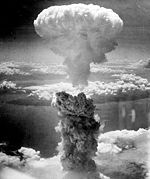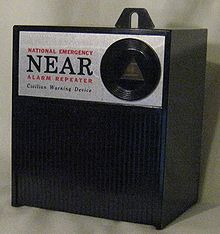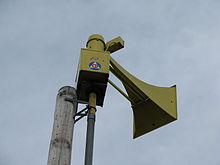- National Emergency Alarm Repeater
-
The National Emergency Alarm Repeater (NEAR) was a civilian emergency warning device in the United States. It was a 2-3"(5-7.5cm) square box designed to plug into a standard 110 volt power outlet to receive a special signal sent over the electric power transmission lines. Research and testing for the NEAR program was developed in 1956 during the cold war to supplement the existing siren warning systems and radio broadcasts in the event of a nuclear attack. The advent of the radio Emergency Broadcast System rendered NEAR obsolete, although a severe disadvantage inherent in the Emergency Broadcast system was that it required a television or radio to be turned on for a household to receive the emergency alarm, NEAR did not. Despite this advantage, upon the introduction of the Emergency Broadcast system, the stockpiled NEAR repeaters were destroyed by their respective manufacturers.[1]A similar program was proposed in the United Kingdom during the 1960s.[2][Full citation needed]
 The mushroom cloud of the atomic bombing of Nagasaki, Japan in 1945 rose some 18 kilometers (11 miles) above the bomb's hypocenter.
The mushroom cloud of the atomic bombing of Nagasaki, Japan in 1945 rose some 18 kilometers (11 miles) above the bomb's hypocenter.
Contents
Time magazine article
A Time magazine article in the November 14, 1960 issue is one of the few pieces of original documentation on the Internet about the device and program.[3] The article outlines a new program that supplements the then "basically unsound" warning system consisting of localized sirens and the CONELRAD radio-alert system.
The U.S. Army argued that in the age of intercontinental ballistic missiles a civil-defense warning system should be capable of warning 90% of the population within 30 seconds after a signal is given by the national civil-defense center in Colorado Springs.
The device is a buzzer installed into common outlets in homes, offices, factories and public buildings. The devices would be set off in an emergency by altering the regular AC signal being generated and transmitted by the local power companies. This would be done by having a specific alternating current of a specific frequency superimposed upon it, the imposed current would be generated by special generators and would be at 270 Hz at 3 volts RMS for 50,000cycles.[4]
The indoor buzzers would be supplemented with outdoor loudspeakers scattered throughout every city. In case of attack, these loudspeakers would carry a warning signal, followed by instructions on what to do.[3]
Patent
The following text from the original patent[5] granted in 1966 describes the device and its use:
The present invention relates to electrical control circuits for producing a delayed action and controlled duration audible alarm, and more particularly to a receiving instrument preferably designed to be used in homes, offices and other buildings as a component of the National Emergency Alarm Repeater (NEAR) system and more particularly to such a receiver incorporating a solid state device for its major control function. The task of providing a means of alerting the Nation of an impending enemy attack or other civil disaster has been given by the United States Congress to the Office of Civil Defense. This office recognized early that some means had to be devised to supplement outdoor sirens in providing more effective warning since sirens often can not be heard indoors, and many suburban and rural areas are not within range of hearing of the nearest municipal siren system. After considerable research and investigation the conclusion was reached that it would be necessary to provide an indoor system which could be coordinated with outdoor warning systems already installed. Such a system must reach the greatest possible number of homes and still not entail undue and prohibitive costs. Therefore it has been decided to use existing electrical power lines and to provide special generators to transmit an electrical signal of controlled frequency and duration over these lines in the event of a national emergency. The generators will be used to superimpose a signal at a frequency of 270 cycles per second on the 60 cycles per second power which is normally transmitted over the power lines. A receiver unit, plugged into an ordinary A.C. wall receptacle, will respond with a loud buzzer-like sound when activated by an actuation signal of sufficient duration. ("US Patent 3,284,791")[4]
An excerpt from a Nuclear Survival Manual
In order to be certain that even sleeping persons can be alerted, your government has perfected a device which plugs into any electric outlet serviced by a public utility. This box emits a very distinctive signal when our warning system determines that enemy missiles or aircraft are on their way for an attack. It will probably sell for a nominal price. The system is called the NEAR project. Some power stations have already been equipped to trigger the signal. Others are being similarly equipped and the entire system should be operational in the near future. The signal device is automatic and performs the function of a nuclear attack alarm clock. A person's chances of survival are enhanced by the careful planning and preparation which will enable him to make the best possible use of whatever warning time is available. ("Nuclear Survival Manual : BOSDEC - The Concrete Curtain") [6]
Featured on History Detectives
An episode of the PBS television program History Detectives featured the NEAR device.[7]
History detective Gwen Wright investigates a NEAR device marked “Essex Wire Corporation”, found by Wayne Gilbert and a friend in a box of computer parts at a hamfest in Colorado. The friend beat Gilbert to it, but soon determined that it was a "Cold War artifact", and called the next day offering to sell it to Gilbert.[8]
Gilbert is aware that the civil defense triangle on the front of the device denotes programs intended to help American citizens survive a Soviet nuclear attack. Gilbert would like Wright and the History Detectives to find out if the device was mass produced, and what the device was used for.
During her investigation Wright suggests that in the early 1960s the Cold War debate over civil defense policies escalated following the Berlin Crisis of 1961, initiating the age of fallout shelters and films like Duck and Cover.
Wright visited a local historian in Charlotte, Michigan with a different looking NEAR device made by a division of General Motors. Charlotte, Michigan was selected as a NEAR testing site in 1960 and the device comes from the archives.[1]
In a United States Civil Defense Administration memo Wright learns the program was launched in 1956. The program tested the inexpensive internal warning system for the home and work. At the sign of an attack, NORAD in Colorado Springs would send an alert to a power company where the signal would travel through the electric transmission lines to activate the NEAR devices in homes and businesses. The device was activated by a special high frequency electric current that had to be initiated by the power company.
One of the problems with the program was there was limited instructions on what to do and no follow-up information on what was exactly happening. Also, when alarms sounded people would get in their cars and leave the area causing traffic to jam the highways. The tests, ran in different communities, identified these problems. After a full decade of Federal support for testing and development, the program was terminated.[1]
References
- ^ a b c "Investigations: N.E.A.R Device (Transcript)" (PDF). 207 KB, History Detectives. PBS. http://www-tc.pbs.org/opb/historydetectives/static/media/transcripts/2011-05-22/709_near.pdf. August 2009. No. 8, season 7. Retrieved 23 October 2011.
- ^ Personal communication: Wayne Gilbert, August 4, 2009
- ^ a b "CIVIL DEFENSE: Buzzers Mean Bombs". TIME. November 14, 1960. http://www.time.com/time/magazine/article/0,9171,711937,00.html. Retrieved May 19, 2010.
- ^ a b US application 3284791, VOIGT, Robert H. & OSBORNE, Jack D., "Near alarm receiver having-time delay of discharge type", published November 08, 1966, p.3, lines 32-43. Retrieved October 23, 2011
- ^ US patent 3284791, Voigt, R. H.; Osborne, J. D., "Near alarm receiver having-time delay of discharge type", published November 08, 1966, p.3, lines 11-43
- ^ Fairchild, James R. (1963) (PDF, 26.7 MB,). Nuclear Survival Manual: BOSDEC - The Concrete Curtain (First ed.). Drexel Winslow & Farrington. pp. 200. http://ia700306.us.archive.org/28/items/nuclearsurvivalm00fairrich/nuclearsurvivalm00fairrich.pdf. LCCN 63-21932
- ^ "Investigations: N.E.A.R Device". History Detectives. PBS. August 2009. No. 8, season 7. Transcript. (207 KB, PDF, pp.11)
- ^ Wayne, Gilbert (August 14, 2009). "The Cold War Artifact that NEAR-ly Changed My Life". Denver Post. http://yourhub.denverpost.com/Page/YourHub/UGC/78/7866/78669_/78669___/78669/Post/2009/08/78669_10019_646500.xml. Retrieved 23 October 2011. "Both of us reached, but he was faster, and the NEAR device went home with him. ...my friend called, ... and in due course offered me the NEAR device for a paltry sum."
External links
- "Status of NEAR program still cloudy to utilities". Electrical World. December 18, 1961. http://coldwar-c4i.net/NEAR/ElectricalWorld121861-36-37.html.
- "National Emergency Alarm Repeater (NEAR) System" The Electronic Encyclopaedia of Civil Defense and Emergency Management, Walter G. Green III, Ph.D (Editor). 25 November 2004
- "Office of Civil Defense Program: 1966 Summary" PDF (2.98 MB), Sect. III: Warning Systems, Federal Warning Systems, page 9. para. 3. Mentions the N.E.A.R. device.
- Gilbert, Wayne (August 14, 2009) "The Cold War Artifact that NEAR-ly Changed My Life" Denverpost.com
- "Nuclear Survival Manual: BOSDEC - The Concrete Curtain" PDF (26.7 MB), 1963, www.archive.org
- Original Patent document: "US 3,284,791", of one type of NEAR receiver
Categories:- Warning systems
- Emergency Alert System
- Disaster preparedness in the United States
Wikimedia Foundation. 2010.



